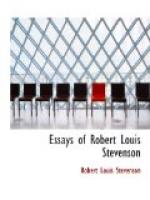[Note 19: Colonel Newcome ... Fred Bayham ... Mr. Barnes ... Falstaff ... Barabbases ... Hazlitt ... Northcote. Colonel Newcome, the great character in Thackeray’s The Newcomes (1854). Fred Bayham and Barnes Newcome are persons in the same story. One of the best essays on Falstaff is the one printed in the first series of Mr. Augustine Birrell’s Obiter Dicta (1884). This essay would have pleased Thackeray. One of the finest epitaphs in literature is that pronounced over the supposedly dead body of Falstaff by Prince Hal—“I could have better spared a better man.” (King Henry IV, Part I, Act V, Sc. 4.) Barabbas was the robber who was released at the time of the trial of Christ.... William Hazlitt (1778-1830), the well-known essayist, published in 1830 the Conversations of James Northcote (1746-1831). Northcote was an artist and writer, who had been an assistant in the studio of Sir Joshua Reynolds. Stevenson projected a Life of Hazlitt, but later abandoned the undertaking. (Life, I, 230.)]
[Note 20: The quality of mercy. See Portia’s wonderful speech in the Merchant of Venice, Act IV, Scene I.]
[Note 21: Joan of Arc. The famous inspired French peasant girl, who led the armies of her king to victory, and who was burned at Rouen in 1431. She was variously regarded as a harlot and a saint. In Shakspere’s historical plays, she is represented in the basest manner, from conventional motives of English patriotism. Voltaire’s scandalous work, La Pucelle, and Schiller’s noble Jungfrau von Orleans make an instructive contrast. She has been the subject of many dramas and works of poetry and fiction. Her latest prominent admirer is Mark Twain, whose historical romance Joan of Arc is one of the most carefully written, though not one of the most characteristic of his books.]
[Note 22: “So careless of the single life.” See Tennyson’s In Memoriam, LV, where the poet discusses the pessimism caused by regarding the apparent indifference of nature to the happiness of the individual.
“Are God and Nature then at strife,
That Nature lends such evil dreams?
So careful of the type she seems,
So careless of the single life.”]
[Note 23: Shakespeare ... Sir Thomas Lucy. The familiar tradition that Shakspere as a boy was a poacher on the preserves of his aristocratic neighbor, Sir Thomas Lucy. See Halliwell-Phillipps’s Outlines of the Life of Shakespeare. In 1879, at the first performance of As You Like It at the Stratford Memorial Theatre, the deer brought on the stage in Act IV, Scene 2, had been shot that very morning by H.S. Lucy, Esq., of Charlecote Park, a descendant of the owner of the herd traditionally attacked by the future dramatist.]
[Note 24: Atlas. In mythology, the leader of the Titans, who fought the Gods, and was condemned by Zeus to carry the weight of the vault of heaven on his head and hands. In the sixteenth century the name Atlas was given to a collection of maps by Mercator, probably because a picture of Atlas had been commonly placed on the title-pages of geographical works.]




